

Dunnottar Castle. Dunnottar Castle (Scottish Gaelic: Dùn Fhoithear, "fort on the shelving slope"[1]) is a ruined medieval fortress located upon a rocky headland on the north-east coast of Scotland, about 3 kilometres (1.9 mi) south of Stonehaven.
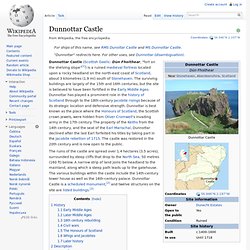
Aberdeen, Aberdeenshire and Moray. Dunnottar Castle Feature Page on Undiscovered Scotland. The rock on which Dunnottar Castle stands might have been designed specifically to permit the building of the most impregnable fortress in Scotland.
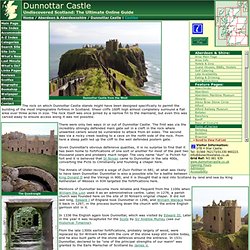
Sheer cliffs 160ft high almost completely surround a flat area over three acres in size. The rock itself was once joined by a narrow fin to the mainland, but even this was carved away to ensure access along it was not possible. There were only two ways in or out of Dunnottar Castle. The first was via the incredibly strongly defended main gate set in a cleft in the rock where unwanted callers would be vulnerable to attack from all sides. The second was via a rocky creek leading to a cave on the north side of the rock. Given Dunnottar's obvious defensive qualities, it is no surprise to find that it has been home to fortifications of one sort or another for most of the past two thousand years and probably much longer.
The Annals of Ulster record a siege of Duin Foither in 681, at what was likely to have been Dunnottar. Read about Thomas D. Scottish Castles Photo Library - Dunottar Castle, Aberdeenshire. Location The ruins of Dunnottar Castle are located 160 feet high on a rocky outcrop on the north-east coast of Aberdeenshire, about two miles south of Stonehaven.
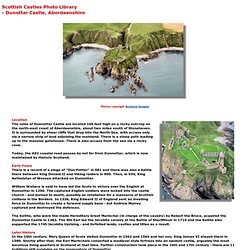
It is surrounded by sheer cliffs that drop into the North Sea, with access only via a narrow strip of land adjoining the mainland. There is a steep path leading up to the massive gatehouse. There is also access from the sea via a rocky cove. Today, the A92 coastal road passes by not far from Dunnottar, which is now maintained by Historic Scotland. Early Years There is a record of a siege of "Dún Fother" in 681 and there was also a battle there between King Donald II and Viking raiders in 900. Historical perspective for Dunnottar Castle. A historical perspective, drawn from the Ordnance Gazetteer of Scotland: A Survey of Scottish Topography, Statistical, Biographical and Historical, edited by Francis H.

Groome and originally published in parts by Thomas C. Jack, Grange Publishing Works, Edinburgh between 1882 and 1885. Dunnottar Castle, a ruined fortress on the coast of Dunnottar parish, 1½ mile S by E of Stonehaven. It crowns the flat summit, 4½ acres in extent, of a stupendous rock, which, somewhat resembling that of Edinburgh Castle, is all but severed from the mainland by a chasm, and on all other sides rises sheer from the sea to a height of 160 feet. Dunnotter_leaflet_2011.pdf. The Honours of Scotland. Dunnottar Castle. Dunnottar Castle. Dunnottar Castle is located just off the main A92, Stonehaven/Montrose road, less than two miles south of Stonehaven, Aberdeenshire.
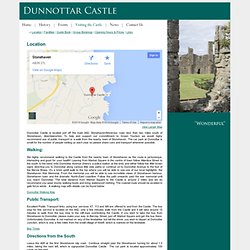
To help and support our committment to Green Tourism we would highy recommend use of public transport or a walk from the nearby town of Stonehaven. The car park at Dunnottar is small for the number of people visiting us each year so please share cars and transport wherever possible. Walking: We highly recommend walking to the Castle from the nearby town of Stonehaven as the route is picturesque, interesting and good for your health! Leaving from Market Square in the centre of town follow Allardice Street to the south to the bend onto Dunnottar Avenue (there’s a police station at the end) and either follow the little brown signs directing you to Dunnottar along various little side paths or continue on to Dunnottar Avenue to the foot of the Bervie Braes.
Dunnottar Walking Map Public Transport: Bus Times. Dunnottar Castle. Dunnottar Castle. Pictish times The site on which the Castle sits has been inhabited since Pictish times (5000 BC to 700 AD) although an exact date is not known.
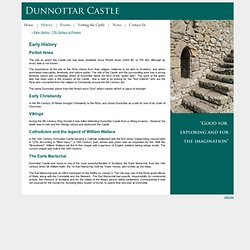
Dunnottar Castle. The Honours of Scotland In 1649 Charles I, King of both England and Scotland was executed by Oliver Cromwell, the self-proclaimed Lord Protector. In 1650, his young son Charles II arrived in North East Scotland, and stayed a night in Dunnottar on his journey south to give battle for his fathers' two kingdoms. In England, on hearing of the young Kings arrival, Oliver Cromwell was so enraged that he ordered the invasion of Scotland. In some haste Charles II was crowned at Scone, but the "Honours of Scotland", the crown and other regalia, could not be returned to Edinburgh Castle, as it had been taken by Cromwell's army. Having already destroyed the English crown jewels, the Honours of Scotland were the most potent icon of monarchy, and as such were next on Cromwell's list.
Site Record for Dunnottar Castle Details Details. Dunnottar Castle - Stonehaven. Kirriemur to Dunnottar Castle - Between the Grampian Mountains and the sea - a lovely area with quiet roads.

Kirriemuir has produced many people with musical connections. The best known is the writer and creator of Peter Pan: J.M.Barrie. His house is in Brechin Road, it's maintained by the National Trust (at one point there was a proposal to ship the whole thing to America). The original Wendy House sits behind the main house - watch out when you go in - Hook's enemy, the crocodile that took off his arm, lies in wait for the unwary visitor! The Wendy House was, in reality, a wash house but that didn't stop Barrie from making it into his first theatre. Stonehaven is more known as a tourist town than a fishing port nowadays, however it has a very attractive harbour and a wealth of hotels, pubs, B&Bs and shops. Dunnottar Castle, Aberdeen. Less than two miles south of Stonehaven and fifteen miles from Aberdeen, on the east coast of Scotland, are the spectacular ruins of Dunnottar Castle.

It stands on an enormous flat-topped rock with sheer cliffs on three sides overlooking the North Sea. A sense of drama fills you as you wander around the expanse dotted with remnants of Scotland’s historic past. You are surrounded by sea with seabirds wheeling and screaming around the cliffs below you. It is an ideal place for bird watching as there is plenty of nesting in the cliffs. No wonder this site was chosen in Pictish times as place of strength and by Saint Ninian as a place of retreat. Dunnottar Castle.
Scotland Image - Dunnottar Castle, Scotland. Dunnottar Castle. Dunnottar Castle Dunottar Castle, now a ruin, is near Stonehaven and about 15 miles south of Aberdeen.
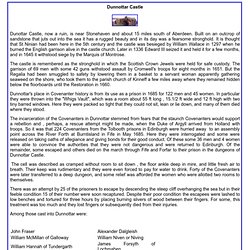
Built on an outcrop of sandstone that juts out into the sea it has a rugged beauty and in its day was a fearsome stronghold. Dunnottar Castle, Scotland. Ancient Scotland - Dunnottar Castle. Dunnottar Castle Reviews - Aberdeenshire, Scotland Attractions. Dunnottar Castle- from Stonehaven. Dunnottar Castle, The History. Dramatic and imposing, on its cliff-top perch, near Stonehaven in the Grampian region, Dunnottar Castle is a breath-taking spectacle; the ancient walls seem to breathe history from every corner.

Between the 9th and 17th centuries the various fortifications were fought over many times. For three centuries the castle was held by the Keith family who were Grand Marischals of Scotland. It's station was a quite one in the 5th century when it became the home of one of St. Ninian's many churches.But this was transferred in the late 14th century two miles inland to where the present Dunnottar Parish Church lies close to the Carron River in Dunnottar Woods now designated a Woodland Park. This is when Sir William Keith fortified the castle rock and brought Papal wrath on his head for violating hallowed ground. A famous event of a different kind occurred in 1685, when 167 Covenanters were imprisoned in terrible conditions. History - Scottish History. Dunnottar Castle. Scotland the Movie Location Guide - Hamlet, Dunnottar Castle.
Things to See & Do in Aberdeen - Attractions and Activities › VisitAberdeen. Dunnottar Castle Stonehaven. Dunnottar Castle. Aberdeenshire Council Sites and Monuments Record - Aberdeenshire - NO88SE0007 - DUNNOTTAR CASTLE. Dunnottar Castle, from Stonehaven. Dunnottar Castle is the most spectacular of all ruined coastal fortresses, perched on a gigantic rocky outcrop almost detached from the mainland. It is the highlight of this coastal circuit which extends southwards from the harbour at Stonehaven.
Terrain Well marked coastal path; steep ascent near start and dangerous cliff edges by the path. Road walking on the return. Public Transport Stonehaven is served by both buses and trains Start Stonehaven harbour. Users' reports As well as reading our description of each walking route, you can read about the experiences of others users on this walk and others.There are 3 user reports for this walk - click to read. Write your own report - there's £90 to win at Webtogs each month User RatingLog in to vote Bog Factor (key) Dunnottar Castle, Aberdeenshire. Location: Stonehaven AB39 2TL (map and directions) Located on Scotland’s north-east coast less than two miles south of Stonehaven, Dunnottar Castle is a ruined medieval fortress constructed in the 15th and 16th centuries, though the site’s strategic defensive qualities have made it a location of fortifications for over 2,000 years.
The term ‘Dun’ is Pictish for fort, meaning that there was a known structure here as early as 400 AD. Dunnottar Castle History, Stonehaven, Aberdeenshire. Is there a more dramatic, romantic castle in Scotland than Dunnottar? Standing upon a striking headland, surrounded by almost sheer cliffs on three sides, Dunnottar is not only one of the most beautiful medieval fortresses in Britain, but the site of some of the most fascinating and dramatic events in British history. Over the turbulent centuries it has been burned, rebuilt, and burned again. It has been besieged, visited by saints and queens, and been the setting for dramatic escapes. Dunnottar Castle. Dunnottar Castle is a vast and impressive ruin perched on a great rocky headland.
A steep path leads down the cliffside and up to the entrance gate, protected by large gun loops from the guardroom. The way continues through two tunnels to the grassed courtyard, with bowling green to the north and churchyard to the south (with one tiny grave from 1685). The buildings round the quadrangle and large well comprise the Silver House (re-roofed in 1927), with seven chambers below what was the 15th century ballroom.
The north and east range have a series of the Whigs Vault. 122 men and 45 women were imprisoned in the Whigs Vault in 1685, and some died in making an escape. Dunnator and Deeside Castle Tour Castle Tours. Dunnottar Castle, Scotland: History, Secrets and Pictures. Dunnottar Castle - Dunnottar castle is situation just 2 miles south of Stonehaven and around 15 miles shy of Aberdeen. Dunnottar Castle - Dunnottar. Dunnottar Castle has won convincingly in VisitScotland's '8th Wonder' poll.